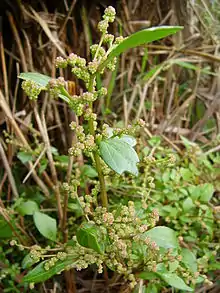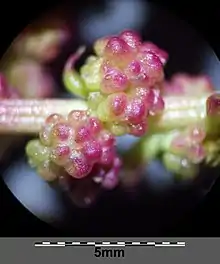| Oxybasis chenopodioides | |
|---|---|
 | |
| A flowering low goosefoot plant | |
| Scientific classification | |
| Kingdom: | Plantae |
| Clade: | Tracheophytes |
| Clade: | Angiosperms |
| Clade: | Eudicots |
| Order: | Caryophyllales |
| Family: | Amaranthaceae |
| Genus: | Oxybasis |
| Species: | O. chenopodioides |
| Binomial name | |
| Oxybasis chenopodioides (L.) S.Fuentes, Uotila & Borsch | |
| Synonyms[1] | |
|
List
| |
Oxybasis chenopodioides,[2] (syn. Chenopodium chenopodioides) is a species of flowering plant in the family Amaranthaceae known by the common name low goosefoot.
It grows in wet non-saline and saline soils, such as mudflats, salt marshes, and lake margins.[3]
Description
Saltmarsh Goosefoot is an annual herb, up about 30 cm (sometimes as much as 50 cm) tall, but often growing prostrate along the ground. Its roots are short and fibrous, and the whole plant is easily lifted out of the soil. The stem is angular and often branched towards the base, with the branches generally occurring in (subopposite) pairs. The whole plant is glabrous (hairless), albeit sometimes with mealy vesicular hairs on the leaves, and it can be either green or crimson in colour (often both).[4][5]
The leaves are alternate, with a short (ca. 0.8 cm) petiole and no stipules. The leaf blades can be up to 8 cm long by 6 cm wide, but are usually much smaller than this, typically 2-3 cm long. The lamina is quite thick and fleshy, triangular to ovate in outline, and will be either entire (untoothed) or just with a few obscure teeth on the margin.[4][6]

Flowering occurs from July to September in northern Europe. The inflorescences are technically panicles, with a branched structure and clusters of glomerules (bunches of flowers on very short stalks) but they often look like spikes (sessile flowers on a single stem). The glomerules consist of 10-20 small, red flowers of two types: the terminal ones are bisexual, with 5 tepals, 5 stamens and 2 stigmas; the lateral ones can be bisexual or female with 3-5 tepals and 0-3 stamens. The fruit is an achene which falls while still contained within the perianth.[4][7]

Taxonomy
The original name (basionym) of this species was Blitum chenopodioides, as coined by Linnaeus in his work Mantissa plantarum in 1771. Under the Linnaean system, the genus Blitum was differentiated from Chenopodium by having just one (rather than five) stamens. This strict reliance on flower structure declined with time, however, and it has until recently been known as Chenopodium chenopodioides, the name assigned to it by Paul Aellen in 1933. However, in 2012, an analysis of the relationships of the many species in the Chenopodioideae by Susy Fuentes-Bazan and colleagues resulted in its reassignment to the new genus Oxybasis, along with red goosefoot and some related plants.[8][9]
A large number of other synonyms have been coined over the years, most notably Blitum botryoides (by Solomon Drejer in 1877) and B. crassifolium (by Heinrich Reichenbach in 1832). A full list is given in Plants of the World Online.[8]
Several subspecies and varieties have been named over the years but none is currently accepted, although Sell & Murrell recently described var. lengyleianum Aellen as an erect and richly branched plant, while var. degenianum Aellen is a prostrate form. They may be kept separate by self-pollination.[4]
The generic name Oxybasis was coined by Grigorij Karelin and Ivan Kirilov in 1841,[9] while chenopodioides means "like a goosefoot." In England it is known as saltmarsh goosefoot, while Americans call it low goosefoot or buttered goosefoot.[10][11]
Distribution
Sources differ on the natural range of Oxybasis chenopodioides. According to Plants of the World Online it is from Europe and the Mediterranean to Xinjiang in China.[1] World Plants lists, as of 2023, lists parts of North America as part of its natural range.[12] While the Jepson Flora Project lists it as a native of South America.[13] Regardless of its native range or where it is an introduced species, it can now be found across the world in the Americas, Africa, Europe, and Asia.[3][1][12]
References
- 1 2 3 "Oxybasis chenopodioides (L.) S.Fuentes, Uotila & Borsch". Plants of the World Online. Royal Botanic Gardens, Kew. Retrieved 27 November 2023.
- ↑ Susy Fuentes-Bazan, Pertti Uotila, Thomas Borsch: A novel phylogeny-based generic classification for Chenopodium sensu lato, and a tribal rearrangement of Chenopodioideae (Chenopodiaceae). In: Willdenowia. Vol. 42, No. 1, 2012, p. 15-16.
- 1 2 "Chenopodium chenopodioides". Flora of China @ efloras.org. Retrieved 30 November 2023.
- 1 2 3 4 Sell, Peter; Murrell, Gina (2018). Flora of Great Britain and Ireland, vol 1. Cambridge: Cambridge University Press.
- ↑ Stace, C.A. (2019). New Flora of the British Isles. Suffolk. ISBN 978-1-5272-2630-2.
{{cite book}}: CS1 maint: location missing publisher (link) - ↑ Poland, John; Clement, Eric (2009). The Vegetative Key to the British Flora. Southampton: John Poland. ISBN 978-0-9560144-0-5.
- ↑ Preston, C.D.; Pearman, D.A.; Dines, T.D. (2002). New Atlas of the British and Irish Flora. Oxford: Oxford University Press.
- 1 2 "Oxybasis chenopodioides (L.) S.Fuentes, Uotila & Borsch". Global Biodiversity Information Forum. Retrieved 25 November 2023.
- 1 2 Fuentes-Bazan, S.; Uotila, P.; Borsch, T. (2012). "A novel phylogeny-based generic classification for Chenopodium sensu lato, and a tribal rearrangement of Chenopodioideae (Chenopodiaceae)". Willdenowia. 42: 5–24.
- ↑ Jepson Manual Treatment
- ↑ "Low Goosefoot". Wildflower Search. Retrieved 25 November 2023.
- 1 2 Hassler, Michael (25 November 2023). "Oxybasis". World Plants. Synonymic Checklist and Distribution of the World Flora. Version 18.2. Retrieved 30 November 2023.
- ↑ Clemants, Steven E.; Benet-Pierce, Nuri (2012). "Chenopodium chenopodioides". Jepson Flora Project (eds.) Jepson eFlora. University of California, Berkeley. Retrieved 30 November 2023.
External links